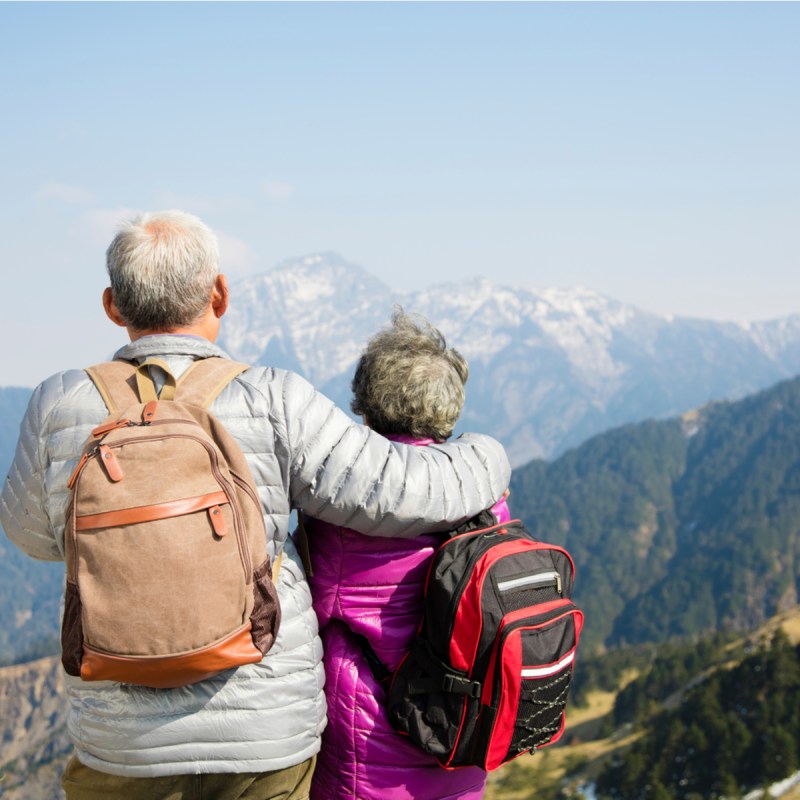
Enough can’t be said about the benefits of walking. It increases your heart and lung fitness, decreases the risk of heart attack and stroke, makes your bones stronger, and gives you better balance. The list goes on and on.
Videos by TravelAwaits
Now, add a little scenery to that walk — mountain streams, breathtaking vistas, sparkling waterfalls — and you have the added bonus of stress relief, lowering your risk of depression, and calming your anxieties.
Sounds great, doesn’t it? For those of us over 50, there are several things you need to consider before lacing up those boots and hitting the trail, everything from planning your trip, knowing what to carry, and most importantly, how to get your body ready for the trail.
Here are 12 tips to help you get on the trail and take your first hike. Remember, these are tips for getting ready for your first day hike, not an overnight or extended backpacking trip.
1. Check With Your Doctor Beforehand
It doesn’t matter what your age is, you should always check with your doctor before doing any strenuous activity, especially if you have lived a sedentary lifestyle which many of us did during the pandemic.

2. Plan, Plan, Plan
Got the “all clear” from the doctor? Don’t lace up the boots quite yet. A common mistake made by first-time hikers is reading in a guidebook or online about a hike with incredible landscapes and just go for it only to find the terrain is too much for them to handle.
Don’t fall into that trap. Getting in shape for a hike is as easy as taking a walk. Start by taking a daily stroll around your neighborhood, gradually building up the length and speed of the walk. Eventually, add a few hills. If you live in a flat area, find some stairs to climb.
As you build your stamina and strength, you may want to consider loading your day pack and wearing it on your walk to help strengthen your back muscles. There are also some excellent exercises that you can do at home to get you ready for your adventures.
3. Pack Wisely
Even though we are only focusing on day hiking and not a long distance hike through a wilderness, you still need to pack some essentials to make the hike more enjoyable and keep you safe.
If you are doing a simple hike of only an hour or two, a fanny pack with a few energy snacks and bottles of water (more on that in a moment) will do. For a full-day hike, get yourself a good quality day pack. Don’t skimp on this. Get a quality pack that can be fitted to your body. You and your back will thank me later. Your local outfitter can help you make the right choice.
What do you pack? Here is a list of a few essentials you should have with you:
- Plenty of energy snacks and lunch plus extra portions in case of emergency
- Plenty of water (see # 4)
- Navigation tools like map and compass, GPS, cell phone (with caveats. See # 7)
- Small first-aid kit
- Weather appropriate clothing (think dressing in layers)
- Hiking boots or shoes
- Sunscreen
- Flashlight
Once you take that first hike, you will get a feeling for what you need and what you don’t and can adjust your gear list accordingly.

4. Stay Hydrated!
The single most important thing you can do when hiking any distance is to stay hydrated. Don’t wait until you’re thirsty before you drink water because by then, you are already dehydrated.
It is recommended that you drink one-half to one quart of water and electrolytes for every hour of hiking. To mix it up a bit, consider drinking water during one break then a sports drink with electrolytes the next.
And don’t stop drinking when you leave the trail! Doctors say that the body underestimates your fluid needs so keep drinking water and electrolytes for a bit longer as you head home.
5. Plan Your Route Carefully
Don’t let your first hike be a death march. There are plenty of guidebooks, online resources, and apps that make finding that perfect first hike a cinch. Read them carefully. A good reference will tell you the approximate time it will take to hike a trail and its difficulty. If it doesn’t, avoid that trail as your first hike. Read the hike details carefully for any sign that there may be obstacles along the route that could spell trouble — climbing rocks, fording swift flowing streams, etc.
A good place to start is at your local state park where the trails are usually well blazed and there are paths for every level of experience and difficulty, plus there will be people nearby who can help you in case of an emergency.
6. Stretch Before You Hike
As we get older, our muscles lose their elasticity, our joints weaken, and we start to lose our range of motion. Hiking puts your body through some strenuous moves that can cause serious injury if you’re not prepared. After hopping out of your car at the trailhead, take some time to do some basic stretches. This will loosen up those tight muscles and joints and allow you to enjoy nature without the pain of a pulled ligament or joint injury.
7. Navigating The Trail
Even in a state park, trails can be confusing and you can easily get off the beaten path. Bring your cell phone but remember, signals can be sketchy or non-existent in the woods. Unless you’re planning a hike on a well traveled trail or with experienced hikers, consider bringing along a GPS with fresh batteries (and know how to use it) to keep track of your location.
Every hiker should learn about orienteering (using a map and compass) to navigate and bring them with you as a backup.

8. Consider Using Trekking Poles Or Walking Sticks
Until I turned 50, I never used a trekking pole but as I grew older, my balance became a bit shaky as I forded streams, climbed down steep inclines, and going back up them — especially with a day pack full of gear. Now I never leave home without them. You may think they are a hindrance and will be a nuisance while navigating the trail, but trust me, they provide that extra bit of security as you walk.
9. Check the Weather Well In Advance
The one thing that can literally put a damper on a hike is the weather. Trust me, walking even a mile in a cold downpouring rain without rain gear will make you doubt that hiking is the sport for you. Check that weather forecast before heading out and prepare appropriately with the proper gear. If severe weather is in the forecast, reschedule your trip. If you are caught in a thunderstorm, head to lower ground quickly.
10. Hike At Your Own Pace
Don’t be afraid or embarrassed to take frequent breaks. I’ll admit it, I used to feel that way. I’d try to keep up with a group of younger hikers only to find myself dragging farther and farther behind. Pace yourself. Every now and then, take off your pack, sit down, grab a snack and some water and enjoy nature.
11. Watch The Clock
Once you’re on the trail taking in all that nature has to offer, it’s easy to lose track of time. Keep an eye on the clock and make sure that you have plenty of time to be off the trail before sunset.

12. Don’t Hike Alone
Finally, the best advice for any first-time hiker, especially those over 50, is to never hike alone. Your best bet is to find a hiking or environmental group in your area that often leads guided hikes to fascinating areas while showing you the ins and outs of hiking.
Hiking is a popular form of exercise, but if you are over age 50, there are some things you should know before you go:
If you want to give hiking a try, there are some excellent places to hone your skill:
